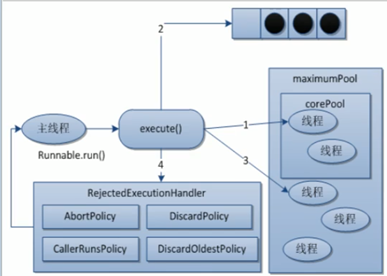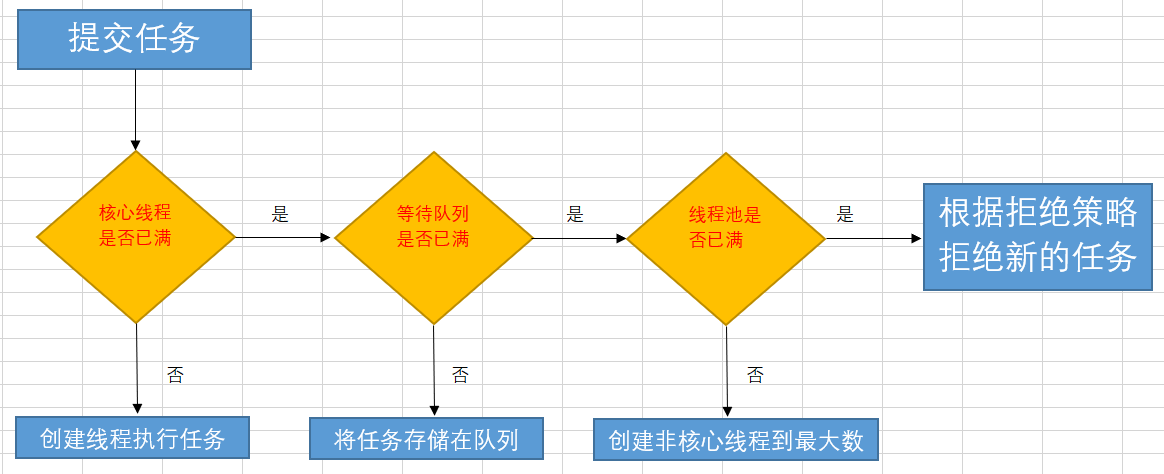自定义线程池详解
一、java.util.concurrent包下的ThreadPoolExecutor
线程池基本概念
概念:线程池主要是控制运行线程的数量,将待处理任务放到等待队列,然后创建线程执行这些任务。如果超过了最大线程数,则等待。
优点:
- 线程复用:不用一直new新线程,重复利用已经创建的线程来降低线程的创建和销毁开销,节省系统资源。
- 提高响应速度:当任务达到时,不用创建新的线程,直接利用线程池的线程。
- 管理线程:可以控制最大并发数,控制线程的创建等。
体系:Executor→ExecutorService→AbstractExecutorService→ThreadPoolExecutor。ThreadPoolExecutor是线程池创建的核心类。类似Arrays、Collections工具类,Executor也有自己的工具类Executors。
线程池三种常用创建方式
newFixedThreadPool:使用LinkedBlockingQueue实现,定长线程池。
public static ExecutorService newFixedThreadPool(int nThreads) {
return new ThreadPoolExecutor(nThreads, nThreads,
0L, TimeUnit.MILLISECONDS,
new LinkedBlockingQueue<Runnable>());
}
newSingleThreadExecutor:使用LinkedBlockingQueue实现,一池只有一个线程。
public static ExecutorService newSingleThreadExecutor() {
return new FinalizableDelegatedExecutorService(new ThreadPoolExecutor(1, 1,
0L, TimeUnit.MILLISECONDS,
new LinkedBlockingQueue<Runnable>()));
}
newCachedThreadPool:使用SynchronousQueue实现,变长线程池。
public static ExecutorService newCachedThreadPool() {
return new ThreadPoolExecutor(0, Integer.MAX_VALUE,
60L, TimeUnit.SECONDS,
new SynchronousQueue<Runnable>());
}
线程池创建的七个参数
| 参数 | 意义 |
|---|---|
| corePoolSize | 线程池常驻核心线程数 |
| maximumPoolSize | 能够容纳的最大线程数 |
| keepAliveTime | 空闲线程存活时间 |
| unit | 存活时间单位 |
| workQueue | 存放提交但未执行任务的队列 |
| threadFactory | 创建线程的工厂类 |
| handler | 等待队列满后的拒绝策略 |
理解:线程池的创建参数,就像一个银行。
corePoolSize就像银行的“当值窗口“,比如今天有2位柜员在受理客户请求(任务)。如果超过2个客户,那么新的客户就会在等候区(等待队列workQueue)等待。当等候区也满了,这个时候就要开启“加班窗口”,让其它3位柜员来加班,此时达到最大窗口maximumPoolSize,为5个。如果开启了所有窗口,等候区依然满员,此时就应该启动”拒绝策略“handler,告诉不断涌入的客户,叫他们不要进入,已经爆满了。由于不再涌入新客户,办完事的客户增多,窗口开始空闲,这个时候就通过keepAlivetTime将多余的3个”加班窗口“取消,恢复到2个”当值窗口“。
线程池底层原理
原理图:上面银行的例子,实际上就是线程池的工作原理。

流程图:

新任务到达→
如果正在运行的线程数小于corePoolSize,创建核心线程;大于等于corePoolSize,放入等待队列。
如果等待队列已满,但正在运行的线程数小于maximumPoolSize,创建非核心线程;大于等于maximumPoolSize,启动拒绝策略。
当一个线程无事可做一段时间keepAliveTime后,如果正在运行的线程数大于corePoolSize,则关闭非核心线程。
线程池的拒绝策略
当等待队列满时,且达到最大线程数,再有新任务到来,就需要启动拒绝策略。JDK提供了四种拒绝策略,分别是。
- AbortPolicy:默认的策略,直接抛出
RejectedExecutionException异常,阻止系统正常运行。 - CallerRunsPolicy:既不会抛出异常,也不会终止任务,而是将任务返回给调用者。
- DiscardOldestPolicy:抛弃队列中等待最久的任务,然后把当前任务加入队列中尝试再次提交任务。
- DiscardPolicy:直接丢弃任务,不做任何处理。
实际生产使用哪一个线程池?
单一、可变、定长都不用!原因就是FixedThreadPool和SingleThreadExecutor底层都是用LinkedBlockingQueue实现的,这个队列最大长度为Integer.MAX_VALUE,显然会导致OOM。所以实际生产一般自己通过ThreadPoolExecutor的7个参数,自定义线程池。
ExecutorService threadPool=new ThreadPoolExecutor(2,5,
1L,TimeUnit.SECONDS,
new LinkedBlockingQueue<>(3),
Executors.defaultThreadFactory(),
new ThreadPoolExecutor.AbortPolicy());
自定义线程池参数选择
对于CPU密集型任务,最大线程数是CPU线程数+1。对于IO密集型任务,尽量多配点,可以是CPU线程数*2,或者CPU线程数/(1-阻塞系数)。
二、SpringBoot 的默认线程池-ThreadPoolTaskExecutor
1、了解与使用
ThreadPoolTaskExecutor是springboot提供的默认线程池 。也就是说如果没有自定义线程池,那么会自动装配这个默认的。
In the absence of an Executor bean in the context, Spring Boot auto-configures a ThreadPoolTaskExecutor with sensible defaults that can be automatically associated to asynchronous task execution (@EnableAsync) and Spring MVC asynchronous request processing.
在springboot当中,根据 官方文档的说明,如果没有配置线程池的话,springboot会自动配置一个ThreadPoolTaskExecutor 线程池到bean当中,我们只需要按照他的方式调用就可以了!!
PS:
ThreadPoolExecutor:这个是JAVA自己实现的线程池执行类,基本上创建线程池都是通过这个类进行的创建!
ThreadPoolTaskExecutor :这个是springboot基于ThreadPoolExecutor实现的一个线程池执行类。
这是默认提供的几个配置参数看一下

拒绝策略默认是超出后抛出RejectedExecutionException异常并直接丢弃。
以下是springboot默认的线程池配置,可以在application.properties文件当中进行相关的设置!!!
# 核心线程数
spring.task.execution.pool.core-size=8
# 最大线程数
spring.task.execution.pool.max-size=16
# 空闲线程存活时间
spring.task.execution.pool.keep-alive=60s
# 是否允许核心线程超时
spring.task.execution.pool.allow-core-thread-timeout=true
# 线程队列数量
spring.task.execution.pool.queue-capacity=100
# 线程关闭等待
spring.task.execution.shutdown.await-termination=false
spring.task.execution.shutdown.await-termination-period=
# 线程名称前缀
spring.task.execution.thread-name-prefix=task-
package com.xiaotong.cleandata.config;
import org.springframework.beans.factory.annotation.Value;
import org.springframework.boot.context.properties.ConfigurationProperties;
import org.springframework.context.annotation.Bean;
import org.springframework.context.annotation.Configuration;
import org.springframework.scheduling.concurrent.ThreadPoolTaskExecutor;
/**
* 自定义线程池配置
* @date 2021年2月21日14:28:26
* @author Lvshiyang
*/
@Configuration
@ConfigurationProperties(prefix = "spring.task.execution")
public class ThreadPoolConfiguration {
@Value("${pool.core-size}")
private int corePoolSize;
@Value("${pool.max-size}")
private int maxPoolSize;
@Value("${pool.queue-capacity}")
private int queueCapacity;
@Value("${pool.keep-alive}")
private int keepAliveSeconds;
@Value("${thread-name-prefix}")
private String threadNamePrefix;
@Bean(name = "threadPoolTaskExecutor")
public ThreadPoolTaskExecutor threadPoolTaskExecutor() {
ThreadPoolTaskExecutor pool = new ThreadPoolTaskExecutor();
pool.setCorePoolSize(corePoolSize);//核心线程池数
pool.setMaxPoolSize(maxPoolSize); // 最大线程数
pool.setQueueCapacity(queueCapacity);//队列容量,当核心线程数达到最大时,新任务会放在队列中排队等待执行
pool.setKeepAliveSeconds(keepAliveSeconds);//线程空闲时间
pool.setAllowCoreThreadTimeOut(false);//核心线程会一直存活,即使没有任务需要执行。(默认false)时,核心线程会超时关闭
pool.setThreadNamePrefix(threadNamePrefix);//线程前缀名称
//默认:AbortPolicy 丢弃任务,抛运行时异常
//CallerRunsPolicy由调用线程处理该任务
pool.setRejectedExecutionHandler(new java.util.concurrent.ThreadPoolExecutor.CallerRunsPolicy());
return pool;
}
}
使用方式:
@Resource(name="threadPoolTaskExecutor")
ThreadPoolTaskExecutor threadPoolTaskExecutor;
threadPoolTaskExecutor.execute(() -> {
//业务代码
});
如果想知道什么时候执行完可搭配CountDownLatch,主线程countDownLatch.await()等待即可。也可以使用待返回参数的Fulture.get()处理。
2、深入springboot默认的线程池
根据官方文档的说明,Spring Boot auto-configures a ThreadPoolTaskExecutor 。最终找到springboot的线程池自动装配类:TaskExecutionAutoConfiguration
@Bean
@ConditionalOnMissingBean
public TaskExecutorBuilder taskExecutorBuilder(TaskExecutionProperties properties, ObjectProvider<TaskExecutorCustomizer> taskExecutorCustomizers, ObjectProvider<TaskDecorator> taskDecorator) {
Pool pool = properties.getPool();
TaskExecutorBuilder builder = new TaskExecutorBuilder();
builder = builder.queueCapacity(pool.getQueueCapacity());
builder = builder.corePoolSize(pool.getCoreSize());
builder = builder.maxPoolSize(pool.getMaxSize());
builder = builder.allowCoreThreadTimeOut(pool.isAllowCoreThreadTimeout());
builder = builder.keepAlive(pool.getKeepAlive());
Shutdown shutdown = properties.getShutdown();
builder = builder.awaitTermination(shutdown.isAwaitTermination());
builder = builder.awaitTerminationPeriod(shutdown.getAwaitTerminationPeriod());
builder = builder.threadNamePrefix(properties.getThreadNamePrefix());
Stream var10001 = taskExecutorCustomizers.orderedStream();
var10001.getClass();
builder = builder.customizers(var10001::iterator);
builder = builder.taskDecorator((TaskDecorator)taskDecorator.getIfUnique());
return builder;
}
同时在ThreadPoolTaskExecutor源码当中可以看到线程池的初始化方式是直接调用的ThreadPoolExecutor进行的初始化。
protected ExecutorService initializeExecutor(ThreadFactory threadFactory, RejectedExecutionHandler rejectedExecutionHandler) {
BlockingQueue<Runnable> queue = this.createQueue(this.queueCapacity);
ThreadPoolExecutor executor;
if (this.taskDecorator != null) {
executor = new ThreadPoolExecutor(this.corePoolSize, this.maxPoolSize, (long)this.keepAliveSeconds, TimeUnit.SECONDS, queue, threadFactory, rejectedExecutionHandler) {
public void execute(Runnable command) {
Runnable decorated = ThreadPoolTaskExecutor.this.taskDecorator.decorate(command);
if (decorated != command) {
ThreadPoolTaskExecutor.this.decoratedTaskMap.put(decorated, command);
}
super.execute(decorated);
}
};
} else {
executor = new ThreadPoolExecutor(this.corePoolSize, this.maxPoolSize, (long)this.keepAliveSeconds, TimeUnit.SECONDS, queue, threadFactory, rejectedExecutionHandler);
}
if (this.allowCoreThreadTimeOut) {
executor.allowCoreThreadTimeOut(true);
}
this.threadPoolExecutor = executor;
return executor;
}
同时会发现默认的线程池拒绝策略是: AbortPolicy 直接抛出异常!!!
private RejectedExecutionHandler rejectedExecutionHandler = new AbortPolicy();
3、使用自定义的线程池
在默认配置信息里面是没有线程池的拒绝策略设置的方法的,如果需要更换拒绝策略就需要自定义线程池,并且如果项目当中需要多个自定义的线程池,又要如何进行管理呢?
自定义Configuration
第一步:创建一个ThreadPoolConfig 先只配置一个线程池,并设置拒绝策略为CallerRunsPolicy
@Configuration
public class ThreadPoolConfig {
@Bean("taskExecutor")
public Executor taskExecutor() {
ThreadPoolTaskExecutor taskExecutor = new ThreadPoolTaskExecutor();
//设置线程池参数信息
taskExecutor.setCorePoolSize(10);
taskExecutor.setMaxPoolSize(50);
taskExecutor.setQueueCapacity(200);
taskExecutor.setKeepAliveSeconds(60);
taskExecutor.setThreadNamePrefix("myExecutor--");
taskExecutor.setWaitForTasksToCompleteOnShutdown(true);
//线程池中任务等待时间,超过等待时间直接销毁
taskExecutor.setAwaitTerminationSeconds(60);
//修改拒绝策略为使用当前线程执行
taskExecutor.setRejectedExecutionHandler(new ThreadPoolExecutor.CallerRunsPolicy());
//初始化线程池
taskExecutor.initialize();
return taskExecutor;
}
}
4、配置多个自定义线程池
/**
* @author shf
* @date 2022-03-14 11:46
*/
@Configuration
public class ThreadPoolConfig {
/**
* 核心线程数 默认的核心线程数为1
*/
private static final int CORE_POOL_SIZE = 2;
/**
* 最大线程数 默认的最大线程数是Integer.MAX_VALUE
*/
private static final int MAX_POOL_SIZE = 20;
/**
* 缓冲队列数 默认的缓冲队列数是Integer.MAX_VALUE
*/
private static final int QUEUE_CAPACITY = 50;
/**
* 允许线程空闲时间 默认的线程空闲时间为60秒
*/
private static final int KEEP_ALIVE_SECONDS = 30;
@Bean("destroyResource")
public AsyncTaskExecutor destroyImGroupTaskExecutor() {
return getAsyncTaskExecutor("del-resource-td-", MAX_POOL_SIZE, QUEUE_CAPACITY);
}
@Bean("statisticsData")
public AsyncTaskExecutor statisticsDataExecutor() {
return getAsyncTaskExecutor("save-data-td-", MAX_POOL_SIZE, QUEUE_CAPACITY);
}
@Bean("commonTaskExecutor")
public AsyncTaskExecutor get() {
return getAsyncTaskExecutor("common-ex-td-", MAX_POOL_SIZE, QUEUE_CAPACITY);
}
private AsyncTaskExecutor getAsyncTaskExecutor(String threadNamePrefix
, int MAX_POOL_SIZE, int QUEUE_CAPACITY) {
ThreadPoolTaskExecutor taskExecutor = new ThreadPoolTaskExecutor();
taskExecutor.setCorePoolSize(CORE_POOL_SIZE);
taskExecutor.setMaxPoolSize(MAX_POOL_SIZE);
taskExecutor.setQueueCapacity(QUEUE_CAPACITY);
taskExecutor.setKeepAliveSeconds(KEEP_ALIVE_SECONDS);
taskExecutor.setThreadNamePrefix(threadNamePrefix);
taskExecutor.setRejectedExecutionHandler(new ThreadPoolExecutor.CallerRunsPolicy());
return taskExecutor;
}
}
使用:
@Autowired
ThreadPoolTaskExecutor commonTaskExecutor; //会去匹配 @Bean("commonTaskExecutor") 这个线程池
如果是使用的@Async注解,只需要在注解里面指定bean的名称就可以切换到对应的线程池去了。如下所示:
@Async("commonTaskExecutor")
public void hello(String name){
logger.info("异步线程启动 started."+name);
}
5、使用异步注解@Async注意事项
总结@Async可能失效的原因
1.@SpringBootApplication启动类当中没有添加@EnableAsync注解。
2.异步方法使用注解@Async的返回值只能为void或者Future。
3.没有走Spring的代理类。因为@Transactional和@Async注解的实现都是基于Spring的AOP,而AOP的实现是基于动态代理模式实现的。那么注解失效的原因就很明显了,有可能因为调用方法的是对象本身而不是代理对象,因为没有经过Spring容器管理。
解决方法:
这里具体说一下第三种情况的解决方法。
1、注解的方法必须是public方法。
2、注解的方法不要定义为static
3、方法一定要从另一个类中调用,也就是从类的外部调用,类的内部调用是无效的。
4、如果需要从类的内部调用,需要先获取其代理类。
三、自定义拒绝策略
ThreadPoolExecutor内部有实现4个拒绝策略,默认为AbortPolicy策略
CallerRunsPolicy:由调用execute方法提交任务的线程来执行这个任务
AbortPolicy:抛出异常RejectedExecutionException拒绝提交任务
DiscardPolicy:直接抛弃任务,不做任何处理
DiscardOldestPolicy:去除任务队列中的第一个任务,重新提交
线程池中,有三个重要的参数,决定影响了拒绝策略:corePoolSize - 核心线程数,也即最小的线程数。workQueue - 阻塞队列 。 maximumPoolSize - 最大线程数
当提交任务数大于 corePoolSize 的时候,会优先将任务放到 workQueue 阻塞队列中。当阻塞队列饱和后,会扩充线程池中线程数,直到达到 maximumPoolSize 最大线程数配置。此时,再多余的任务,则会触发线程池的拒绝策略了。
总结起来,也就是一句话,当提交的任务数大于(workQueue.size() + maximumPoolSize ),就会触发线程池的拒绝策略。
拒绝策略的源码
CallerRunsPolicy
/**
* A handler for rejected tasks that runs the rejected task
* directly in the calling thread of the {@code execute} method,
* unless the executor has been shut down, in which case the task
* is discarded.
* 用于拒绝任务的处理程序,
* 可以直接在{@code execute}方法的调用线程中运行被拒绝的任务
* 除非执行器已被关闭,否则将丢弃该任务。
*/
public static class CallerRunsPolicy implements RejectedExecutionHandler {
/**
* Creates a {@code CallerRunsPolicy}.
* 创建一个{@code CallerRunsPolicy}。
*/
public CallerRunsPolicy() { }
/**
* Executes task r in the caller's thread, unless the executor
* has been shut down, in which case the task is discarded.
* 除非执行器已关闭,否则在调用者线程中执行任务,
* r 在这种情况下,该任务将被丢弃。
*
* @param r the runnable task requested to be executed
* r 请求执行的可运行任务
* @param e the executor attempting to execute this task
* e 尝试执行此任务的执行者
*/
public void rejectedExecution(Runnable r, ThreadPoolExecutor e) {
if (!e.isShutdown()) {
r.run();
}
}
}
分析:
CallerRunsPolicy:线程调用运行该任务的 execute 本身。此策略提供简单的反馈控制机制,能够减缓新任务的提交速度。
这个策略显然不想放弃执行任务。但是由于池中已经没有任何资源了,那么就直接使用调用该execute的线程本身来执行。(开始我总不想丢弃任务的执行,但是对某些应用场景来讲,很有可能造成当前线程也被阻塞。如果所有线程都是不能执行的,很可能导致程序没法继续跑了。需要视业务情景而定吧。)
这样生产者虽然没有被阻塞,但提交任务也会被暂停。
但这种策略也有隐患,当生产者较少时,生产者消费任务的时间里,消费者可能已经把任务都消费完了,队列处于空状态,当生产者执行完任务后才能再继续生产任务,这个过程中可能导致消费者线程的饥饿。
AbortPolicy
/**
* A handler for rejected tasks that throws a
* {@code RejectedExecutionException}.
* 抛出{@code RejectedExecutionException}的拒绝任务处理程序。
*/
public static class AbortPolicy implements RejectedExecutionHandler {
/**
* Creates an {@code AbortPolicy}.
*/
public AbortPolicy() { }
/**
* Always throws RejectedExecutionException.
* 总是抛出RejectedExecutionException
* @param r the runnable task requested to be executed
* @param e the executor attempting to execute this task
* @throws RejectedExecutionException always
*/
public void rejectedExecution(Runnable r, ThreadPoolExecutor e) {
throw new RejectedExecutionException("Task " + r.toString() +
" rejected from " +
e.toString());
}
}
分析:
该策略是默认饱和策略。
使用该策略时在饱和时会抛出RejectedExecutionException(继承自RuntimeException),调用者可捕获该异常自行处理。
DiscardPolicy
/**
* A handler for rejected tasks that silently discards the
* rejected task.
* 拒绝任务的处理程序,默认丢弃拒绝任务。
*/
public static class DiscardPolicy implements RejectedExecutionHandler {
/**
* Creates a {@code DiscardPolicy}.
*/
public DiscardPolicy() { }
/**
* Does nothing, which has the effect of discarding task r.
* 不执行任何操作,这具有丢弃任务 r 的作用。
* @param r the runnable task requested to be executed
* @param e the executor attempting to execute this task
*/
public void rejectedExecution(Runnable r, ThreadPoolExecutor e) {
}
}
分析:
如代码所示,不做任何处理直接抛弃任务
DiscardOldestPolicy
/**
* A handler for rejected tasks that discards the oldest unhandled
* request and then retries {@code execute}, unless the executor
* is shut down, in which case the task is discarded.
* 处理被拒绝任务的处理程序,它丢弃最旧的未处理请求,
* 然后重试{@code execute},
* 除非执行器*被关闭,在这种情况下,该任务将被丢弃。
*/
public static class DiscardOldestPolicy implements RejectedExecutionHandler {
/**
* Creates a {@code DiscardOldestPolicy} for the given executor.
*/
public DiscardOldestPolicy() { }
/**
* Obtains and ignores the next task that the executor
* would otherwise execute, if one is immediately available,
* and then retries execution of task r, unless the executor
* is shut down, in which case task r is instead discarded.
* 获取并忽略执行者*会立即执行的下一个任务(如果一个任务立即可用),
* 然后重试任务r的执行,除非执行者*被关闭,在这种情况下,任务r会被丢弃。
* @param r the runnable task requested to be executed
* @param e the executor attempting to execute this task
*/
public void rejectedExecution(Runnable r, ThreadPoolExecutor e) {
if (!e.isShutdown()) {
e.getQueue().poll();
e.execute(r);
}
}
}
分析:
如代码,先将阻塞队列中的头元素出队抛弃,再尝试提交任务。如果此时阻塞队列使用PriorityBlockingQueue优先级队列,将会导致优先级最高的任务被抛弃,因此不建议将该种策略配合优先级队列使用。
自定义策略
看完发现默认的几个拒绝策略并不是特别的友好,那么可不可以咱们自己搞个呢?
可以发现,所有的拒绝策略都是实现了 RejectedExecutionHandler 接口
public interface RejectedExecutionHandler {
/**
* Method that may be invoked by a {@link ThreadPoolExecutor} when
* {@link ThreadPoolExecutor#execute execute} cannot accept a
* task. This may occur when no more threads or queue slots are
* available because their bounds would be exceeded, or upon
* shutdown of the Executor.
*
* <p>In the absence of other alternatives, the method may throw
* an unchecked {@link RejectedExecutionException}, which will be
* propagated to the caller of {@code execute}.
*
* @param r the runnable task requested to be executed
* @param executor the executor attempting to execute this task
* @throws RejectedExecutionException if there is no remedy
*/
void rejectedExecution(Runnable r, ThreadPoolExecutor executor);
}
这个接口只有一个 rejectedExecution 方法。
r 为待执行任务;executor 为线程池;方法可能会抛出拒绝异常。
那么咱们就可以通过实现 RejectedExecutionHandler 接口扩展
两个栗子:一
netty自己实现的线程池里面私有的一个拒绝策略。单独启动一个新的临时线程来执行任务。
private static final class NewThreadRunsPolicy implements RejectedExecutionHandler {
public void rejectedExecution(Runnable r, ThreadPoolExecutor executor) {
try {
final Thread t = new Thread(r, "Temporary task executor");
t.start();
} catch (Throwable e) {
throw new RejectedExecutionException(
"Failed to start a new thread", e);
}
}
}
两个栗子:二
dubbo的一个例子,它直接继承的 AbortPolicy ,加强了日志输出,并且输出dump文件
public class AbortPolicyWithReport extends ThreadPoolExecutor.AbortPolicy {
@Override
public void rejectedExecution(Runnable r, ThreadPoolExecutor e) {
String msg = String.format("Thread pool is EXHAUSTED!" +
" Thread Name: %s, Pool Size: %d (active: %d, core: %d, max: %d, largest: %d), Task: %d (completed: %d)," +
" Executor status:(isShutdown:%s, isTerminated:%s, isTerminating:%s), in %s://%s:%d!",
threadName, e.getPoolSize(), e.getActiveCount(), e.getCorePoolSize(), e.getMaximumPoolSize(), e.getLargestPoolSize(),
e.getTaskCount(), e.getCompletedTaskCount(), e.isShutdown(), e.isTerminated(), e.isTerminating(),
url.getProtocol(), url.getIp(), url.getPort());
logger.warn(msg);
dumpJStack();
throw new RejectedExecutionException(msg);
}
}
自定义:
背景描述:为什么会有队列拒绝,就是放到线程池的任务大于队列的最大值了,就会进入一个队列拒绝任务的一些策略,包括,报错,直接丢弃等。有自带的一些策略。
但是,有很多时候,我就是不希望它把我的任务丢弃掉,我宁愿让它在那儿等着排队,排队进入线程池的队列,也不能让它把我的任务直接丢弃,这个时候,就用到了自定义拒绝策略了。
参考类似的思路,最简单的做法,我们可以直接定义一个RejectedExecutionHandler,当队列满时改为调用BlockingQueue.put来实现生产者的阻塞:
new RejectedExecutionHandler() {
@Override
public void rejectedExecution(Runnable r, ThreadPoolExecutor executor) {
if (!executor.isShutdown()) {
try {
executor.getQueue().put(r);
} catch (InterruptedException e) {
// should not be interrupted
}
}
}
};
这样,我们就无需再关心Queue和Consumer的逻辑,只要把精力集中在生产者和消费者线程的实现逻辑上,只管往线程池提交任务就行了。
相比最初的设计,这种方式的代码量能减少不少,而且能避免并发环境的很多问题。当然,你也可以采用另外的手段,例如在提交时采用信号量做入口限制等,但是如果仅仅是要让生产者阻塞,那就显得复杂了。




【推荐】国内首个AI IDE,深度理解中文开发场景,立即下载体验Trae
【推荐】编程新体验,更懂你的AI,立即体验豆包MarsCode编程助手
【推荐】抖音旗下AI助手豆包,你的智能百科全书,全免费不限次数
【推荐】轻量又高性能的 SSH 工具 IShell:AI 加持,快人一步
· winform 绘制太阳,地球,月球 运作规律
· 震惊!C++程序真的从main开始吗?99%的程序员都答错了
· AI与.NET技术实操系列(五):向量存储与相似性搜索在 .NET 中的实现
· 超详细:普通电脑也行Windows部署deepseek R1训练数据并当服务器共享给他人
· 【硬核科普】Trae如何「偷看」你的代码?零基础破解AI编程运行原理